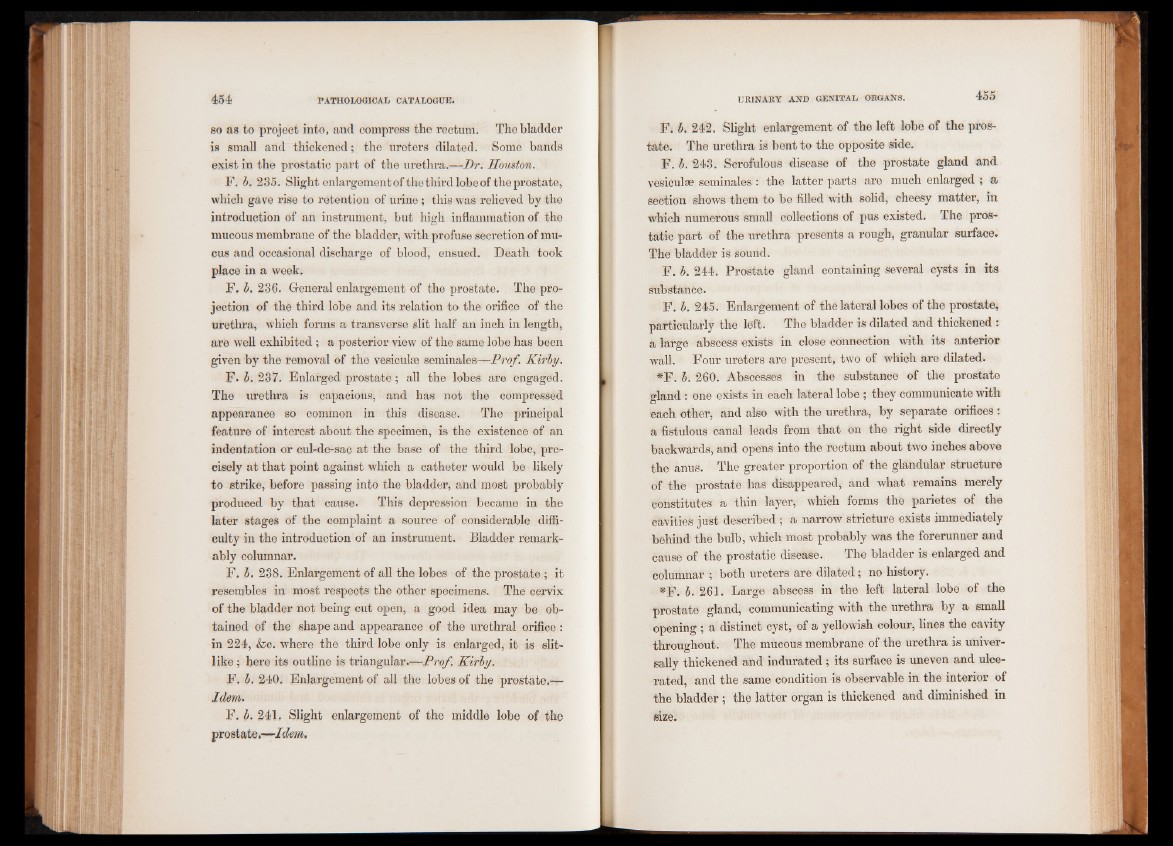
so as to project into, and compress the rectum. The bladder
is small and thickened; the ureters dilated. Some bands
exist in the prostatic part of the urethra.—Dr. Houston.
F. b. 235. Slight enlargement of the third lobe of the prostate,
which gave rise to retention of urine; this was relieved by the
introduction of an instrument, but high inflammation of the
mucous membrane of the bladder, with profuse secretion of mu-
eus and occasional discharge of blood, ensued. Death took
place in a week.
F. b. 236. General enlargement of the prostate. The projection
of the third lobe and its relation to the orifice of the
urethra, which forms a transverse slit half an inch in length,
are well exhibited ; a posterior view of the same lobe has been
given by the removal of the vesiculse seminales—Prof. Kirby.
F. b. 237. Enlarged prostate; all the lobes are engaged.
The urethra is capacious, and has not the compressed
appearance so common in this disease. The principal
feature of interest about the specimen, is the existence of an
indentation or cul-de-sac at the base of the third lobe, precisely
at that point against which a catheter would be likely
to strike, before passing into the bladder, and most probably
produced by that cause. This depression became in the
later stages of the complaint a source of considerable difficulty
in the introduction of an instrument. Bladder remarkably
columnar.
F. b. 238. Enlargement of all the lobes of the prostate ; it
resembles in most respects the other specimens. The cervix
of the bladder not being cut open, a good idea may be obtained
of the shape and appearance of the urethral orifice:
in 224, &c. where the third lobe only is enlarged, it is slitlike
; here its outline is triangular.—Prof. Kirby.
F. b. 240. Enlargement of all the lobes of the prostate.^-
Idem.
F. b. 241. Slight enlargement of the middle lobe of the
prostate.-—Idem,
F. b. 242. Slight enlargement of the left lobe of the prostate.
The urethra is bent to the opposite side.
F. b. 243. Scrofulous disease of the prostate gland and
vesiculse seminales : the latter parts are much enlarged ; a
section shows them to be filled with solid, cheesy matter, in
which numerous small collections of pus existed. The prostatic
part of the urethra presents a rough, granular surface.
The bladder is sound.
F. b. 244. Prostate gland containing several cysts in its
substance.
F. b. 245. Enlargement of the lateral lobes of the prostate,
particularly the left. The bladder is dilated and thickened:
a large abscess exists in close connection with its anterior
wall. Four ureters are present, two of which are dilated.
*F. b. 260. Abscesses in the substance of the prostate
gland: one exists in each lateral lobe ; they communicate with
each other, and also with the urethra, by separate orifices:
a fistulous canal leads from that on the right side directly
backwards, and opens into the rectum about two inches above
the anus. The greater proportion of the glandular structure
of the prostate has disappeared, and what remains merely
constitutes a thin layer, which forms the parietes of the
cavities just described ; a narrow stricture exists immediately
behind the bulb, which most probably was the forerunner and
cause of the prostatic disease. The bladder is enlarged and
columnar ; both ureters are dilated; no history.
*F. b. 261. Large abscess in the left lateral lobe of the
prostate gland, communicating with the urethra by a small
opening ; a distinct cyst, of a yellowish colour, lines the cavity
throughout. The mucous membrane of the urethra is universally
thickened and indurated ; its surface is uneven and ulcerated,
and the same condition is observable in the interior of
the bladder; the latter organ is thickened and diminished in
size.